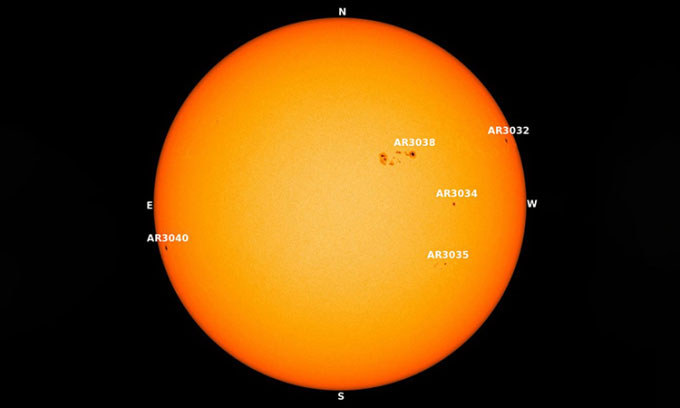Sunspot AR3038 has the potential to produce strong solar flares directed towards Earth, impacting satellites, communication systems, and electrical grids.
A sunspot nearly three times the size of Earth has appeared on the Sun and could cause level M solar flares aimed at our planet in the near future, USA Today reported on June 21. The sunspot, named AR3038, has been growing larger over the past few days, according to Rob Steenburgh, an expert at the National Oceanic and Atmospheric Administration’s (NOAA) Space Weather Prediction Center.

Image of the Sun with sunspots on June 21. (Photo: NASA/SDO)
Steenburgh noted that the size and growth rate of the sunspot remain relatively normal. “Typically, they will grow over time. They will go through various stages before eventually decaying,” he said.
Sunspots appear dark because they are cooler than other areas on the Sun’s surface, according to NASA. They are cooler because they form in regions where strong magnetic fields inhibit heat from the Sun’s interior from reaching the surface.
Solar flares are sudden energy explosions that often originate from sunspots. The intensity of solar flares is classified into levels: A, B, C, M, and the most powerful, X. The larger and more complex the sunspot, the higher the likelihood of producing solar flares.
AR3038 has doubled in size each day for the past three days, said C. Alex Young, deputy director of science at NASA’s Goddard Space Flight Center’s Solar Physics Division, on June 21.
C-level solar flares are too weak to have a significant impact on Earth, according to Andrés Muñoz-Jaramillo, a scientist at the Southwest Research Institute in San Antonio. M-level flares can disrupt radio communications at the Earth’s poles. Earlier this year, an M-level flare caused a geomagnetic storm strong enough to damage dozens of SpaceX’s Starlink satellites.
X-level flares can affect satellites, communication systems, electrical grids, and, in severe cases, lead to power shortages or outages. Weaker solar flares occur more frequently, while X-level flares are rarer.
AR3038 has already produced C-level flares directed towards Earth, Steenburgh mentioned. There have been no M or X-level flares from this sunspot yet, but stronger flares may emerge in the coming week. “The likelihood of flares from this region remains high as the sunspot grows larger and more complex,” he stated.
NOAA’s Space Weather Prediction Center forecasts a 25% – 30% chance of M-level flares in the next three days, and a 5% – 10% chance of X-level flares.


















































